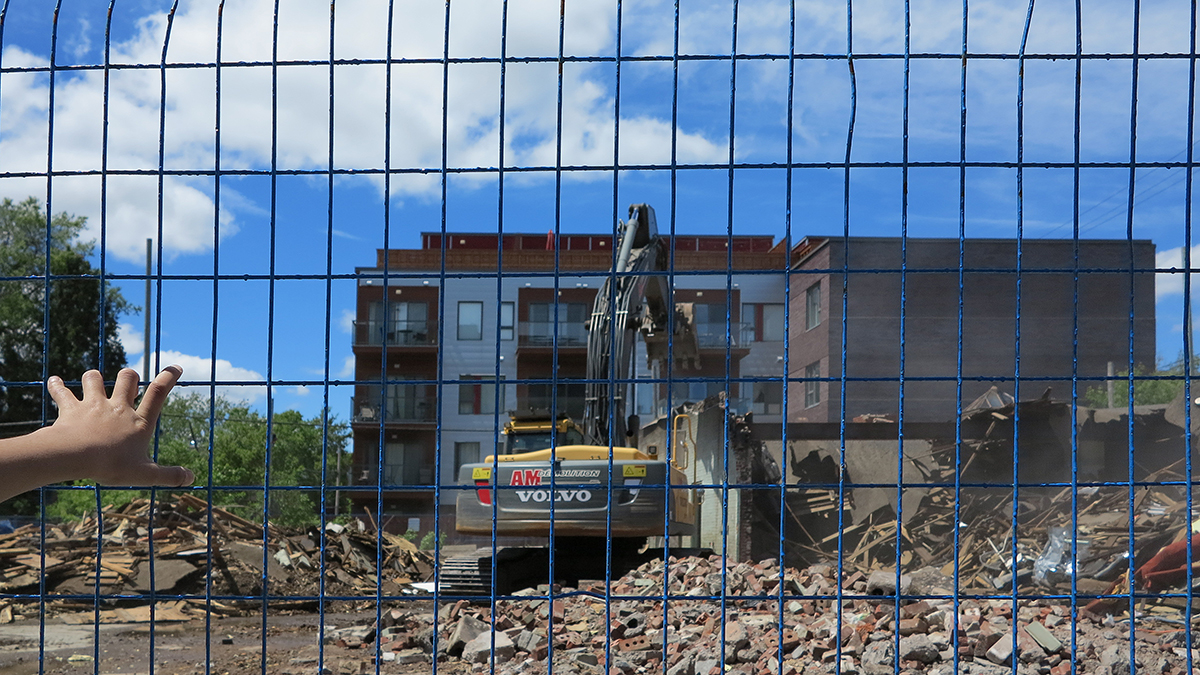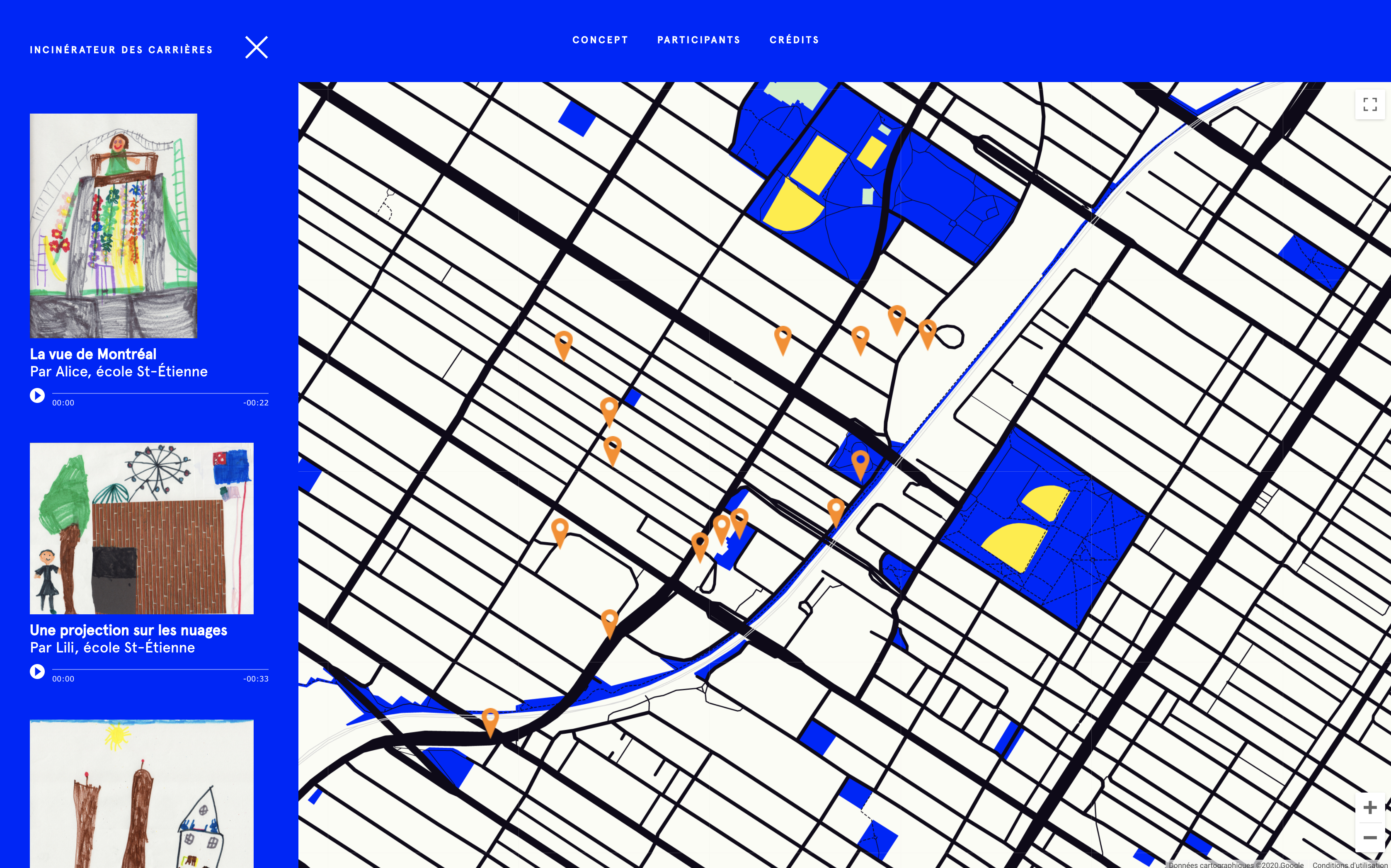
EN
Workshop, Walks, Website and Public Presentation, Marc-Favreau Library, Montreal, QC, CA
Bordered to the south by a railway line, Petite-Patrie has long been a working-class neighborhood. Although changing, the site of the former municipal workshops located there remains surrounded by imposing industrial developments. How to appropriate this urban heritage with few resources? Imagination is an option to consider because, if a city exists because of what you see in it, it evolves because of what you project into it. La Petite-Patrie par sa petite patrie thus awakens children to the history of their neighborhood and the diversity of their current urban environment. Their capacity for wonder is then put to use, as is their propensity to magnify through the imaginary, the everyday, the mundane. In a playful approach, children consider the recreational potential of obsolete or neglected developments that surround them and define, on their own scale, a strategic vision of their living environment.
Combining an artist presentation, an introductory course in town planning and an educational creation workshop, La Petite-Patrie par sa petite patrie is a digital work launched in 2017 following a cycle of activities aimed at young Montreal audiences. Thus, the website is a kind of audio-visual journey listing various moments in a neighborhood in transition. The points of interest displayed on the interactive map of the site were targeted by children aged 4 and 5 from CPE La Petite-Patrie, a kindergarten class and a 5th/6th grade from St.Étienne elementary school and visitors to the Marc-Favreau library and the Oasis Bellechasse. They were, during a walk I conducted, invited to describe their perceptions of sites in their neighborhood and to visualize their potential transformation.
Various experiences and perceptions of a working-class Montreal neighborhood are documented here, as well as the child's vision of Montrealers of today and tomorrow. A large audience is thus encouraged to share its conception of a creative—even utopian—development of its neighborhood.



FR
Atelier de médiation, parcours urbain, site Web et présentation publique à la Bibliothèque Marc-Favreau, Montréal, QC, CA
Bordé au sud par une voie ferrée, la Petite-Patrie a longtemps été un quartier ouvrier. Bien qu’en mutation, le site des anciens ateliers municipaux qui y est situé reste entouré d’aménagements industriels imposants. Comment s’approprier ce patrimoine urbanistique avec peu de moyens? L’imagination est une option а considérer car, si une ville existe par ce que l’on y voit, elle évolue grâce а ce que l’on y projette. Ainsi La Petite-Patrie par sa petite patrie éveille les enfants à l’histoire de leur quartier et à la diversité de leur environnement urbain actuel. Leur capacité d’émerveillement est alors mise à contribution, de même que leur propension à magnifier par l’imaginaire, le quotidien, le banal. Dans une approche ludique, les enfants envisagent les potentiels récréatifs d’aménagements désuets ou négligés qui les entourent et définissent à leur échelle, une vision stratégique de leur milieu de vie.
Combinant présentation d’artiste, parcours d’initiation à l’urbanisme et atelier de création pédagogique, La Petite-Patrie par sa petite patrie est une œuvre numérique lancée en 2017 suite à un cycle d’activités destiné au jeune public montréalais. Ainsi, le site Web est une sorte de parcours audio-visuel répertoriant divers moments d’un quartier en transition. Les points d’intérêts affichés sur la carte interactive du site ont été ciblés par des enfants de 4 et 5 ans du CPE La Petite- Patrie, d’une classe de maternelle et d’une 5e/6e année de l’école St-Étienne voisine et de visiteurs de la bibliothèque Marc-Favreau et de l’Oasis Bellechasse. Ceux-ci ont été, lors d’une balade en ma compagnie, invités à partager leurs anecdotes et perceptions de différents aménagements du quartier et à visualiser leur transformation potentielle.
Diverses expériences et perceptions d’un quartier populaire montréalais sont ici documentées, ainsi que la vision d’enfant de Montréalais-es d’aujourd’hui et de demain. Un vaste public est ainsi incité а partager sa conception d’un aménagement créatif — voire utopique —, de son quartier.



